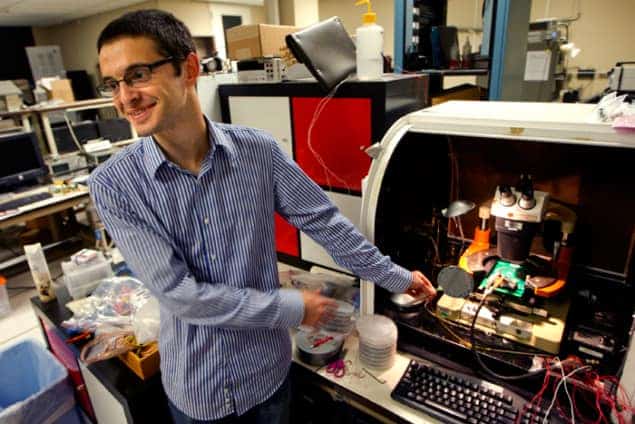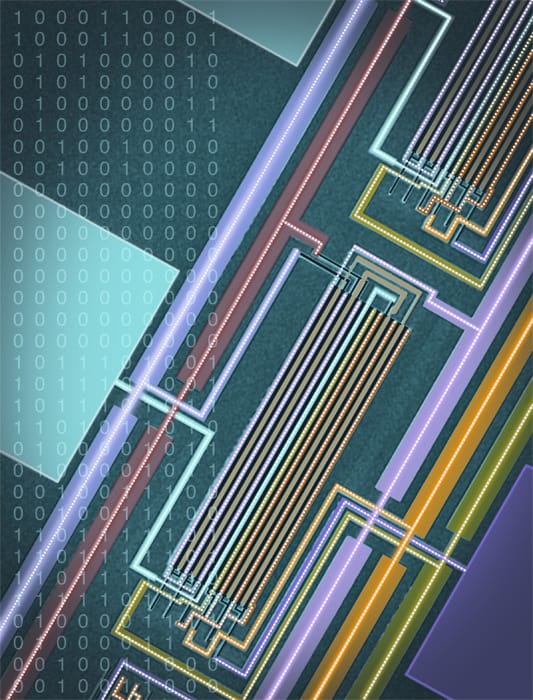
A computer made from tens of thousands of carbon nanotubes has been unveiled by researchers at Stanford University in the US. Described as the first complete computer made from these tiny rolled-up tubes of carbon, the system runs an operating system and can store and execute simple computer programs as well as output the results. The Stanford team says that its work could be an important step towards commercial carbon-nanotube-based computers, which could be faster and more energy-efficient than traditional silicon-based devices.
Carbon nanotubes are drinking-straw-like structures of pure carbon with walls that can be just one atom thick. Like graphene, which is a flat carbon sheet, carbon nanotubes have a range of useful electronic properties that makes them potential building blocks for computers and other electronic devices. Indeed, carbon nanotubes, which can behave as semiconductors, have already been used to create transistors and other electronic devices that could be smaller, faster and more energy-efficient than silicon-based devices.
Researchers have also used nanotubes to create some of the components used in a computer – such as oscillators and half-adders – but integrating carbon-nanotube devices into a full-blown programmable computer that can run stored programs is far from easy. The problem is that these tubes are only a few nanometres in diameter and tens or even hundreds of them have to be placed with great precision on a substrate to create just one transistor. If even just one tube is in the wrong place, then the operation of the device – or even the entire logic circuit – can fail.
Rogue tubes
Another challenge facing anyone wishing to build a nanotube computer is that the electronic properties of each tube are determined by the precise arrangement of its carbon atoms. Some tubes are semiconductors, while others are metals; if the wrong type of tube is used, then the device will not work. So to deal with metallic carbon nanotubes, Stanford’s Max Shulaker and colleagues devised a new bulk process to ensure that any “rogue” metallic tubes in a device are disabled.

This involves switching off all semiconductor nanotubes in the device and then passing a large current through the computer. This electrical energy is channelled through the metallic nanotubes, which become hot and vaporize – but without damaging the rest of the circuit. Shulaker told physicsworld.com that it was important to develop a method of disabling all metallic carbon nanotubes at once – rather than dealing with them individually – because a practical computer would contain billions of such structures.
To minimize the problem of misplaced nanotubes, the team did two things. First, by growing the nanotubes on a crystalline quartz substrate, it ensured that almost all of the tubes – about 99.5%, in fact – were placed in highly aligned arrays on the substrate. However, as this would still not be good enough for a device containing billions of carbon nanotubes, the team carefully designed the layout of the transistors so that the computer will work 100% of the time even if some tubes are in the wrong place.
One bit at a time
Using these new techniques, the team managed to integrate 178 carbon-nanotube-based transistors to create a device that can store and execute a program. Unlike modern computers, which process data in 32- or 64-bit chunks, the Stanford system operates on just one bit. The computer performs one logical operation, which is the “subtract and branch if negative” – or SUBNEG – process. As this process could, in principle, be used to perform any arbitrary calculation as long as enough memory is available, the nanotube system can be considered to be a universal computer despite its basic design.
The Stanford researchers used their computer to perform tasks such as counting and number-sorting. The computer was also able to perform several tasks at once and can run the MIPS commercial instruction set. “People have been talking about a new era of carbon-nanotube electronics moving beyond silicon,” says Subhasish Mitra, who is part of the Stanford team. “But there have been few demonstrations of complete digital systems using this exciting technology. Here is the proof.”
The computer is described in Nature.



